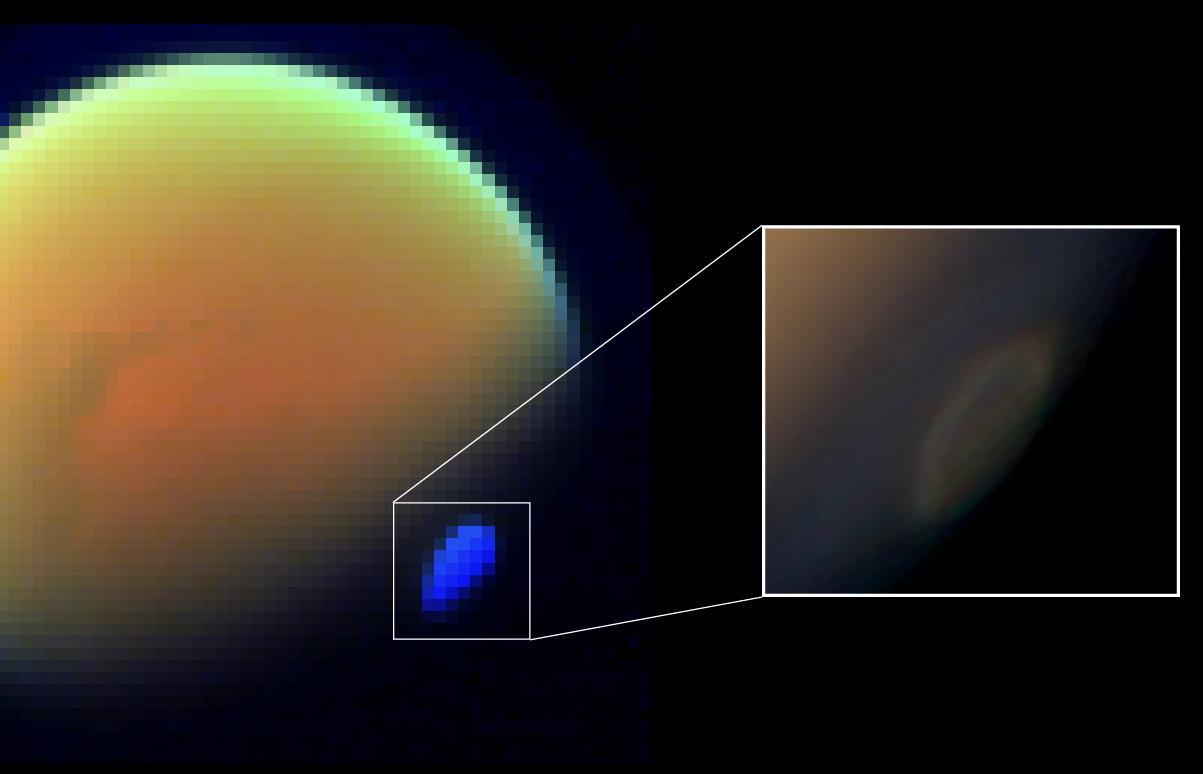Huge Cloud on Saturn's Moon Titan Is Made of Toxic Cyanide

nature: It's made of cyanide gas.
The discovery suggests that the air above Titan's poles can get much cooler than previously thought, scientists said. The huge cloud on Titan — it's about the size of Egypt — was first spotted by NASA's Cassini spacecraft in 2012, but only now is its cyanide composition understood.
Cassini images show that the giant spinning cloud growing over Titan's southern pole covers an area of more than 386,000 square miles (1 million square kilometers). [See more amazing photos of Titan]
"The cloud was first seen in images from Cassini's cameras taken in 2012," study co-author Nick Teanby at the University of Bristol in England said in a statement. "It started off quite small but soon grew to cover the entire south polar region. This was totally unexpected and set us puzzling over what the cloud could be made of."
Titan's giant cyanide cloud
Surprisingly, Cassini found the cloud existed at very high altitudes, about 180 miles (300 km). The presence of a cloud at such heights is unexpected because previous estimates of the temperatures at this altitude have been too high to allow cloud formation.
Unfortunately, while the Cassini images showed that the cloud was very high up, "they did not allow us to figure out what the cloud was actually made of or why it was there," Teanby said in a statement.
Now, after analyzing two more years of data from Cassini, the researchers found this cloud is made of cyanide — specifically, "ice particles of hydrogen cyanide, or 'blauwzuur,' blue acid, as it's known in the Netherlands, which is highly toxic," lead study author Remco de Kok, a planetary scientist at Leiden University in the Netherlands, said in a statement.
Breaking space news, the latest updates on rocket launches, skywatching events and more!
Hydrogen cyanide is expected to condense in Titan's atmosphere at an altitude of about 50 miles (80 km), and research has detected a nearly imperceptible tropical haze layer at this height matching this gas. However, Titan's atmosphere was expected to be too warm at higher altitudes for hydrogen cyanide to form.
"Hydrogen cyanide ice was quite surprising, and not expected at this location," de Kok told Space.com.
This new finding reveals that the polar atmosphere above Titan's south pole must be extremely cold to allow hydrogen cyanide to condense, much cooler than thought possible at those altitudes — minus 234 degrees F (minus 148 degrees C), about 180 F (100 C) colder than once predicted.
The researchers said that very dramatic cooling must be taking place inside the winter vortex of winds over Titan's south pole.
"There may be gases present there that radiate a lot of energy away in the infrared, cooling the atmosphere there," de Kok said.
Seasons on Titan
Titan is the only moon in the solar system with clouds and a dense, planetlike atmosphere. Like Earth, Titan's atmosphere is mostly nitrogen, but unlike modern Earth, methane is the next most important part of Titan's atmosphere. The makeup of Titan's atmosphere resembles certain models of early Earth, before oxygen was a significant component of Earth's atmosphere.
Titan's atmosphere is experiencing a change of seasons, with spring arriving in the north and autumn in the south. Titan has seasons just like Earth, only each season lasts more than seven years instead of three months.
In 2015, Cassini will peer at Titan to help see how cold Titan's south pole is, de Kok noted. "It is exciting thinking about how the cloud might develop in that time," he said.
The Titan cyanide cloud study is detailed in the Oct. 2 edition of the journal Nature.
Follow us @Spacedotcom, Facebook and Google+. Original article on Space.com.

Charles Q. Choi is a contributing writer for Space.com and Live Science. He covers all things human origins and astronomy as well as physics, animals and general science topics. Charles has a Master of Arts degree from the University of Missouri-Columbia, School of Journalism and a Bachelor of Arts degree from the University of South Florida. Charles has visited every continent on Earth, drinking rancid yak butter tea in Lhasa, snorkeling with sea lions in the Galapagos and even climbing an iceberg in Antarctica. Visit him at http://www.sciwriter.us


